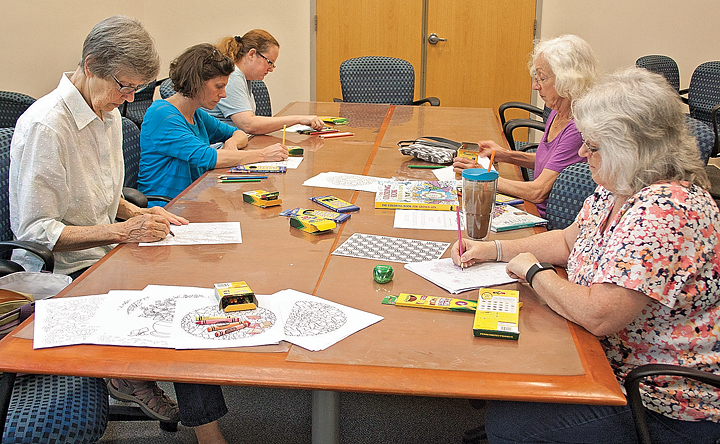In a quiet corner of the Northeast Regional Library on May 12, coloring book pages were strewn across a large table while open boxes of crayons gave the room a faint wax-and-cardboard smell of childhood classrooms. But the six colorers seated around the table were not school kids. They were adults — women who have found relief from the complexities of adulthood in a simple childhood pastime.
One of the women, Linda Olah, pulled out her own coloring book with a cover promising stress relief. Adult coloring has become a popular method of relaxation, as evidenced by the widespread availability of adults coloring books with intricate black-and-white drawings.
“It’s just the new thing for adults to be able to color. It’s acceptable now,” said Jay Pinson, the library assistant who claimed the enviable task of hosting the week’s coloring session. “When this thing first blossomed, the coloring books were expensive, like $25, but now it’s become more mainstream.”
Coloring is “very mind-freeing,” she added, because coloring within the lines doesn’t require much thought. The coloring books offer extremely intricate or abstract designs, but more often Pinson finds herself reaching for the simple drawings.
“I think a lot of us steer away from the abstract ones because it’s too much thinking,” she said, picking up a red colored pencil to shade in a flower.
Dr. Donna Betts, American Art Therapy Association president, confirms Pinson’s feelings. Betts stated that the act of coloring helps improve the ability to concentrate, which reduces feelings of anxiety. When people color, their brains react the same as when they meditate.
UNCW senior Jocelyn Santillián experienced that firsthand when she introduced coloring to the older adults at the Fannie Norwood Memorial Home, where she volunteers.
“It stimulates their brain and can entertain them for hours without making them feel like they are children because there are so many intricate patterns within each page,” she said.
Devon Bartholomew, who colors across the table from Olah and Pinson, said she has heard coloring can be just as effective as drugs in lowering blood pressure. Research backs up her belief and suggests it could help heal other health issues as well.
Studies have investigated meditation to heal different conditions, the National Center for Complementary and Integrative Health reports. There is evidence that it may reduce blood pressure, as well as symptoms of irritable bowel syndrome and flare-ups in people who have ulcerative colitis. It also may ease symptoms of anxiety and depression, and help people with insomnia. Additionally, it could lower incidence, duration and severity of acute respiratory illnesses, such as influenza.
“As a licensed professional counselor, I can tell you we are incorporating [adult coloring books] in treatment plans for clients as a coping skill for those with anxiety and/or depression,” said Jeanette Hurt Gurr of Avita Community Services Board for Mental Health in northeast Georgia. Gurr is the family member of a UNCW student.
“I’ve received a great deal of positive results in helping clients finding a positive distraction from negative thoughts,” she said.
For Pinson, coloring is both relaxing and rewarding. She has completed paintings before, but she wasn’t happy with them because, she said, “I had a different picture in my head of what it was going to look like and my brain and my hand didn’t connect, somehow.”
Art teachers might argue coloring within the lines doesn’t encourage creativity, she admitted, but she likes having the outlines provided.
“I’m not that artistic, so having the lines gives me boundaries,” she said. “I mean, I can make a picture here!”
The women acknowledge that their goal is to make pictures, not artistic masterpieces.
“I guess we’re not really creating anything, we’re just filling in the spaces,” Anna Misner said, reaching for a crayon. “But it’s still fun.”
They don’t even necessarily keep the finished product for that long. At first, Misner collected all of her completed coloring pages, but soon, she said, “it became a burden, [feeling] like you have to do something with it.”
So she shredded them.
“It’s an exercise in letting go,” she explained. “It’s not about ‘have to’ or forever, it’s something you enjoy for a period of time and then you can let it go.”
The adult coloring sessions are just as much about the process as the final product, Misner added. And, more specifically, it’s about sharing that process with others.
“Just being with people is basically what I look for,” Misner said, and several of the other women in the room nodded.
Olah agreed, adding that group coloring “just reminds me of childhood.”
“And isn’t that awesome?” Pinson said, smiling.
Intern Alexandra Golder contributed to this story.
email [email protected]





[…] Hanover Public Library was in the news for helping adults relax and […]